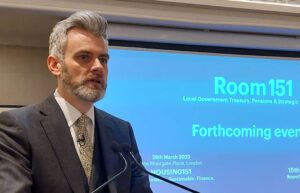Local Government Pension Scheme funds will need a workplace plan as part of new governance requirements. Susan Black uses a Dickens analogy to examine why this should not be a tick-box exercise but an opportunity to create a future generation of LGPS leaders.
 The link between the Charles Dickens classic, A Tale of Two Cities, and governance structures in the Local Government Pension Scheme (LGPS) may not be immediately apparent, but with indications that ministerial approval has been given to relaunch the Good Governance Project, it pays to keep turning the page!
The link between the Charles Dickens classic, A Tale of Two Cities, and governance structures in the Local Government Pension Scheme (LGPS) may not be immediately apparent, but with indications that ministerial approval has been given to relaunch the Good Governance Project, it pays to keep turning the page!
We are in unprecedented economic times, with polarising opinions on the best course of action. The news, like the novel, is all about social inequality, societal resurrection and personal sacrifice. We are anticipating that the outcome of the consultation on the Good Governance Project will see the main recommendations proposed for adoption, together with an additional requirement for funds to have a workforce plan in place.
This new requirement shows the link between the wider environment and the role good governance could play in driving towards the best of times, or, at the very least, minimising the impact of the worst of times.
The new Good Governance requirement about workforce planning is a response to the changing work environment. The focus of any consultation should then be on how to get the most out of workforce planning for the whole scheme.
Governance evolution (not revolution)
We might not need to go as far back as Dickens or the French Revolution to see why good governance needs to respond to the wider environment. An explanation might be found in consideration of the events that have happened since Hymans Robertson was appointed to deliver the Good Governance Project.
In the far-off days of 2019, when pandemics were for movies (or Dickensian novels), those comments in the draft Good Governance Project report that related to resourcing discussed council recruitment freezes and downsizing exercises. By Phase II, discussions were about recruitment and retention practices and budgets being tailored to the fund, rather than imposed by the host authority. By Phase III, the final recommendations envisaged a senior LGPS officer responsible for sufficient resourcing and agreeing budgets with the pensions committee, whilst being cognisant of the need to maximise the value of spend from the public purse.
Having enough people with the right skills to deliver the LGPS was clearly on the mind of the Good Governance project, but it wasn’t a headline. However, when the UK went into lockdown in March 2020 the way we lived our lives fundamentally changed. The Good Governance Phase III report was published in February 2021, just before the spate of resignations in the national workforce, sometimes referred to as The Great Resignation.
The LGPS hasn’t been immune to the impact of home working and, anecdotally, we have heard from some funds about the difficulties in immediate recruitment and in succession planning. Other funds have found the changing work environment to be of help, giving the ability to access a wider pool of talent unencumbered by geography.
The Pensions and Lifetime Savings Association (PLSA) research project, Today’s Challenges, Tomorrow’s Opportunities, published in June 2022, echoes the increased focus on resourcing, making several recommendations designed to address identified challenges in recruiting people with “new skills” in areas such as digital, regulatory and cyber, and the need for a more holistic LGPS-wide approach to talent management.
I would suggest that the new Good Governance requirement about workforce planning is a response to the changing work environment and the concerns raised. The focus of any consultation should then be on how to get the most out of workforce planning for the whole scheme.
Room151’s Monthly Online Treasury Briefing
October 28 2022
Online
Public sector delegates – register here
Workforce planning for best and worst of times
As part of running any organisation, team or business, knowing your resources is key. At the most basic level, a workforce plan could be created by counting the hours worked by staff to quantify your resource and confirming that you are “planning” to use that resource to deliver the LGPS in line with the regulation.
This plan could, however, put you in a tricky position if asked if you had enough resource, even in the short term, and certainly would not let you make decisions to respond to a changing environment. It is unlikely that this is what the additional Good Governance recommendation is looking for and, in any event, it would also be a pointless exercise.
Good strategic workforce planning should benefit everyone by: finding and removing unrealistic targets; identifying and overcoming obstacles to achieving objectives; finding ways to improve efficiency and quality of outputs; and, most importantly, managing the work-life balance of employees. A good plan should be flexible and respond to times of rapid change, for example during a pandemic or significant economic shifts.
The basic process might involve: knowing your organisation and objectives; having data to analyse where you currently are and what you might need in future; finding the gaps between the current and future; taking actions to close gaps; and having a process to continually monitor progress.
However, these are steps that are easy to type and sometimes difficult to implement. As part of business planning, you may already have a clear idea of what you want to achieve over the shorter and longer term, be that achieving basic compliance with regulatory requirements, or achieving best-in-class delivery of the scheme. Taking a data-driven approach to workforce analysis might be more difficult, and planning for an uncertain and unknown future will certainly involve consideration of several scenarios.
This is before you get to working out the gaps, what to do and how to track progress. The data you will need includes everything from financial data to qualitative staff performance and engagement data. And this is only if you are looking to get the benefits of workforce planning at individual fund level, making sure your plan is informed enough to flexibly accommodate the unexpected, be that a budget cut, a pandemic or a skill shortage.
Leveraging workforce planning across the whole LGPS might be a way to drive scheme-wide benefits that could address some of the PLSA findings. If all funds are identifying the same actions to address the same gaps, then it could be a clear trigger that some scheme-wide actions are needed. Arguably, the collaboration evident in the creation of the LGPS procurement frameworks and pooling could find a new focus.
Workforce planning might also be a trigger to consider some of the concerns that were raised in early drafts of the Good Governance Project more deeply, especially given economic uncertainty. If funds find themselves competing for talent, while also dealing with additional local government budget constraints, effective workforce planning could provide funds with the evidence to consider the specialism of pensions roles more appropriately within local authority pay structures and recruitment processes.
Planning for the future shouldn’t all be about headcount, salaries and skills. Predicting what cyber skills people might need in five years is important, but workforce planning should be about considering how you can create a future generation of LGPS leaders.
The moral of the story
 The key moral of A Tale of Two Cities is the idea that things, and people, may not always be what they seem. When it comes to good governance, it can be easy to forget that behind the processes and procedures that govern a fund there are people. Workforce planning makes us take the lofty concept of governance and think about the workforce, or (perhaps more properly) the people we are and the people we work with.
The key moral of A Tale of Two Cities is the idea that things, and people, may not always be what they seem. When it comes to good governance, it can be easy to forget that behind the processes and procedures that govern a fund there are people. Workforce planning makes us take the lofty concept of governance and think about the workforce, or (perhaps more properly) the people we are and the people we work with.
Planning for the future shouldn’t all be about headcount, salaries and skills. Predicting what cyber skills people might need in five years is important, but workforce planning should be about considering how you can create a future generation of LGPS leaders. This might be as straightforward as identifying and costing things you know you want to outsource or it might mean considering how you make sure more junior team members get exposure to the full range of investment, administration and governance work at the appropriate time in their careers. In either event, a bit of investigation might make you realise that you have hidden gems.
Overall, good strategic workforce planning should give you a plan that looks after the people who look after the fund, making sure that all of us, who are resources for the LGPS, are ready for whatever happens, good or bad. So, the final link between the Good Governance Project and A Tale of Two Cities is, hopefully, that it all ends well.
Susan Black is head of governance, administration and projects for the LGPS at Hymans Robertson.
—————
FREE weekly newsletters
Subscribe to Room151 Newsletters
Room151 LinkedIn Community
Join here
Monthly Online Treasury Briefing
Sign up here with a .gov.uk email address
Room151 Webinars
Visit the Room151 channel













